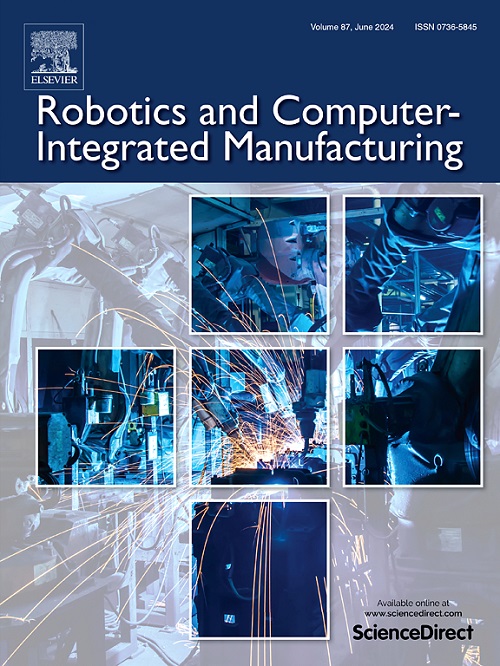Robotic pre-drilled Z-pinning approach for enhancing the performance of composite fan blades in aircraft engines
IF 11.4
1区 计算机科学
Q1 COMPUTER SCIENCE, INTERDISCIPLINARY APPLICATIONS
引用次数: 0
Abstract
Composite fan blades serve as the primary barrier of protection in aircraft engines during the air intake process, and their mechanical properties play a significant role in aviation safety. The interlaminar performance of composite fan blades is relatively weak owing to the layered manufacturing process, rendering them susceptible to delamination under the application of external impact loads. Z-pin insertion is a technique that involves embedding an array of slender and rigid pins through the laminate to reinforce the composite materials by introducing an additional load-bearing medium through their thickness. However, the application of the Z-pin insertion technique presents significant challenges owing to their complex geometries and stringent performance requirements of the composite fan blades in aircraft engines. The intricate shapes of fan blades require the manual execution of the Z-pin insertion process, leading to low production efficiency and consistency. Moreover, the Z-pins that are not embedded along the normal direction of the curved surface can induce defects, such as matrix cracking or fiber misalignment, particularly on curved or irregular fan blade surfaces. Combined with the high stresses and dynamic loads experienced by fan blades during operation, the aforementioned factors complicate the selection of the optimal Z-pin insertion parameters in advanced aerospace applications. This paper presents a robotic pre-drilled Z-pinning (PDZP) approach for improving the performance of composite fan blades in aircraft engines. A series of experiments, including double cantilever beam and end-notched flexure tests, were conducted to obtain the optimal insertion parameters for the robotic PDZP process. Furthermore, a robotic PDZP posture model was developed to embed the Z-pins along the normal direction and to avoid matrix cracking or fiber misalignment in the curved or irregular regions of the fan blade. Additionally, a compensation method was proposed for the normal deviation during the PDZP process. Finally, a prototype of the robotic PDZP system was developed and subjected to impact tests, which demonstrated that the impact resistance of the composite fan blade satisfied the expected requirements.
提高飞机发动机复合材料风扇叶片性能的机器人预钻z型钉钉方法
复合材料风扇叶片是飞机发动机进气过程中的主要防护屏障,其力学性能对航空安全具有重要意义。复合材料风扇叶片由于采用分层制造工艺,其层间性能相对较弱,在外冲击载荷作用下易发生分层。Z-pin插入是一种技术,它涉及在层压板中嵌入一系列细长的刚性pin,通过在其厚度中引入额外的承重介质来增强复合材料。然而,由于航空发动机复合材料风扇叶片的复杂几何形状和严格的性能要求,z销插入技术的应用面临着巨大的挑战。风扇叶片的复杂形状需要手动执行z针插入过程,导致生产效率和一致性较低。此外,未沿曲面法线方向嵌入的z销会导致缺陷,如基体开裂或纤维错位,特别是在弯曲或不规则的风扇叶片表面。再加上风扇叶片在运行过程中所经历的高应力和动态载荷,上述因素使得在先进航空航天应用中选择最佳z针插入参数变得复杂。提出了一种用于提高航空发动机复合材料风扇叶片性能的机器人预钻z型钉钉(PDZP)方法。通过双悬臂梁和端缺口弯曲试验,获得了机器人PDZP工艺的最佳插入参数。此外,开发了一个机器人PDZP姿态模型,以沿法线方向嵌入z -销,并避免在风扇叶片弯曲或不规则区域的基体开裂或纤维错位。此外,针对PDZP过程中的正态偏差,提出了一种补偿方法。最后,开发了机器人PDZP系统样机并进行了冲击试验,结果表明,复合材料风扇叶片的抗冲击性能满足预期要求。
本文章由计算机程序翻译,如有差异,请以英文原文为准。
求助全文
约1分钟内获得全文
求助全文
来源期刊
CiteScore
24.10
自引率
13.50%
发文量
160
审稿时长
50 days
期刊介绍:
The journal, Robotics and Computer-Integrated Manufacturing, focuses on sharing research applications that contribute to the development of new or enhanced robotics, manufacturing technologies, and innovative manufacturing strategies that are relevant to industry. Papers that combine theory and experimental validation are preferred, while review papers on current robotics and manufacturing issues are also considered. However, papers on traditional machining processes, modeling and simulation, supply chain management, and resource optimization are generally not within the scope of the journal, as there are more appropriate journals for these topics. Similarly, papers that are overly theoretical or mathematical will be directed to other suitable journals. The journal welcomes original papers in areas such as industrial robotics, human-robot collaboration in manufacturing, cloud-based manufacturing, cyber-physical production systems, big data analytics in manufacturing, smart mechatronics, machine learning, adaptive and sustainable manufacturing, and other fields involving unique manufacturing technologies.

 求助内容:
求助内容: 应助结果提醒方式:
应助结果提醒方式:


